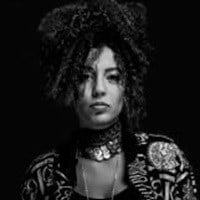#DesignIndaba2018: Fashion with a social conscience

She also showcased her unique talent in fashion at Design Indaba Day Two, unveiling her latest collection on the Artscape stage to enthusiastic applause at the close of her speech. The opening was just as dramatic, showing images of her first collection of eclectic designs, draped over models hung with traditional beads, heavy fabrics interwoven with brilliant colour and patterns, and posed against the stark background of dilapidated cityscapes, ruins and dark alleyways.
Her work is dramatic, patterned, earthy, street wear with a unique interpretation, with gorgeous use of colour and patterned indigenous fabrics.
It portrays women as strong, empowered, which is very different from some indigenous tribes she encountered in Egypt, where women are kept indoors from a young age to work on embroidering their wedding clothes for when they get married off in the mid-teens.
According to her official bio on the Design Indaba website, the fashion designer “combines ethics and aesthetics to create unique, trendy collections” and, “above and beyond the aesthetics, Elshandaweely’s clothing collections unpack issues of identity. Specifically within issues such as Middle Eastern-African identity and colourism.”
She is influenced by these dichotomies in the land of her birth, such as how women across Africa are treated; as well as how dark skin in Egypt is often reviled and discriminated against, yet celebrated and adorned in places like Kenya, which she visited for a different perspective.
Having a darker skin and curly hair herself, Elshandaweely’s first act of defiance and in celebration of darker African skin, she used only dark-skinned models in her first collection, which was lauded for its bravery.
“In Kenya I saw women embracing their hair and darker skin colour. I just wanted to take that back to my country. To let people who are insecure about their skin colour and hair type know that there are other people who love their dark skin.”
She said she didn’t realise she could have such an influence on how people perceived themselves and was overjoyed at the reaction, which opened up conversations in Egypt about race and identity. “I got lots of comments on how I’m affecting people’s lives. I was just a young girl of 22 years... and I realised I could influence people.”
Her second collection was sold out and she was chosen as one of the most successful entrepreneurs in her country.

She is influenced in her collections by current social issues and how people are interacting with one another. She wants to break down stereotypes that exist, like her collection featuring young people in a park, in the hope that older generations would be more accepting of the vibrancy of the youth in a more modern Egypt today.
“Without the revolution, I wouldn’t be standing here in front of you. Back then I worked in corporate. I felt there was proper change happening around me and there were a lot of people aiming for change.”
She launched her latest collect at Design Indaba with graffiti artists from Africa. “I wanted to remind people there is hope. Does revolution really affect people? I’m just doing it.
“Through art, we are the people who can change the world. That is why I am standing here.”







